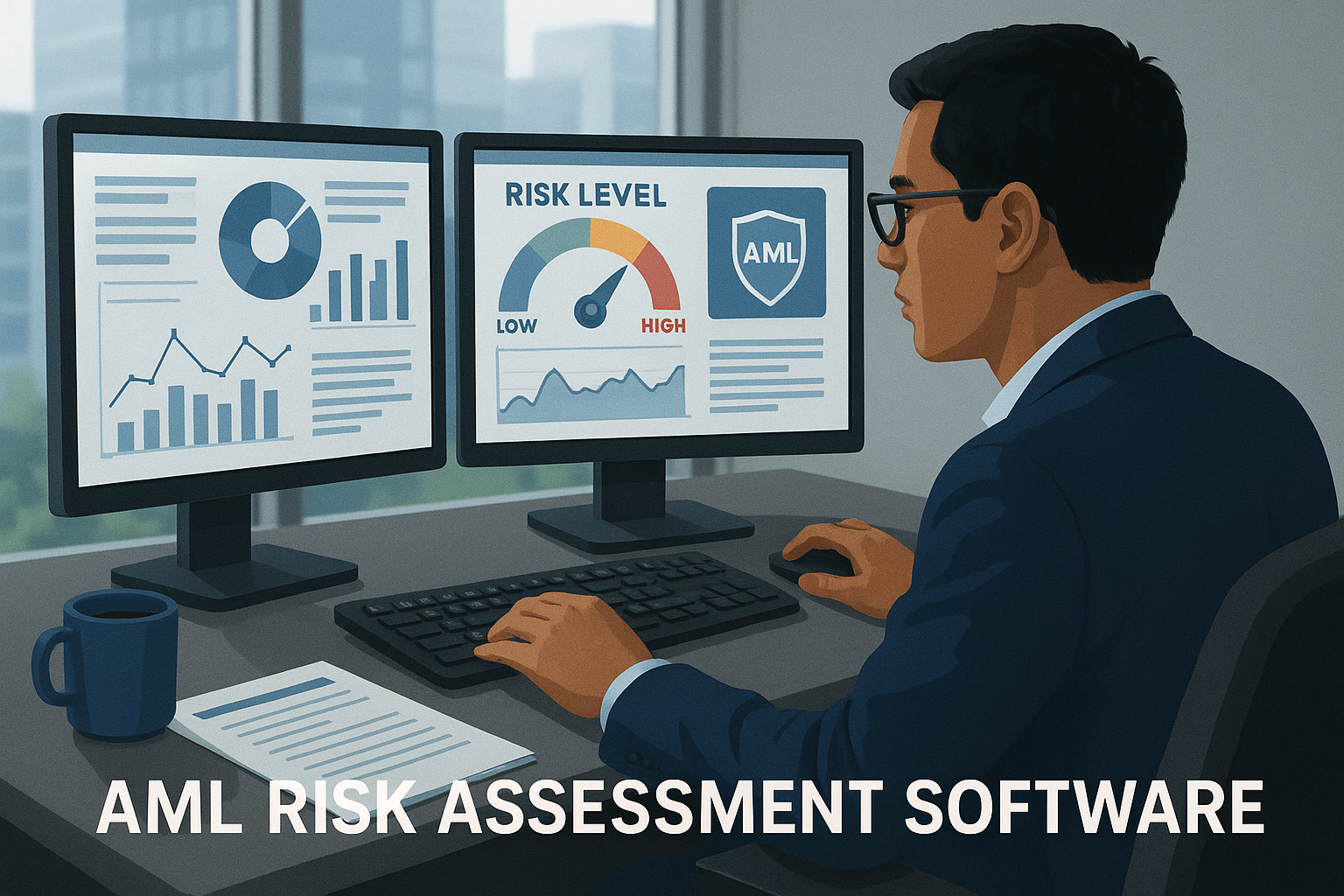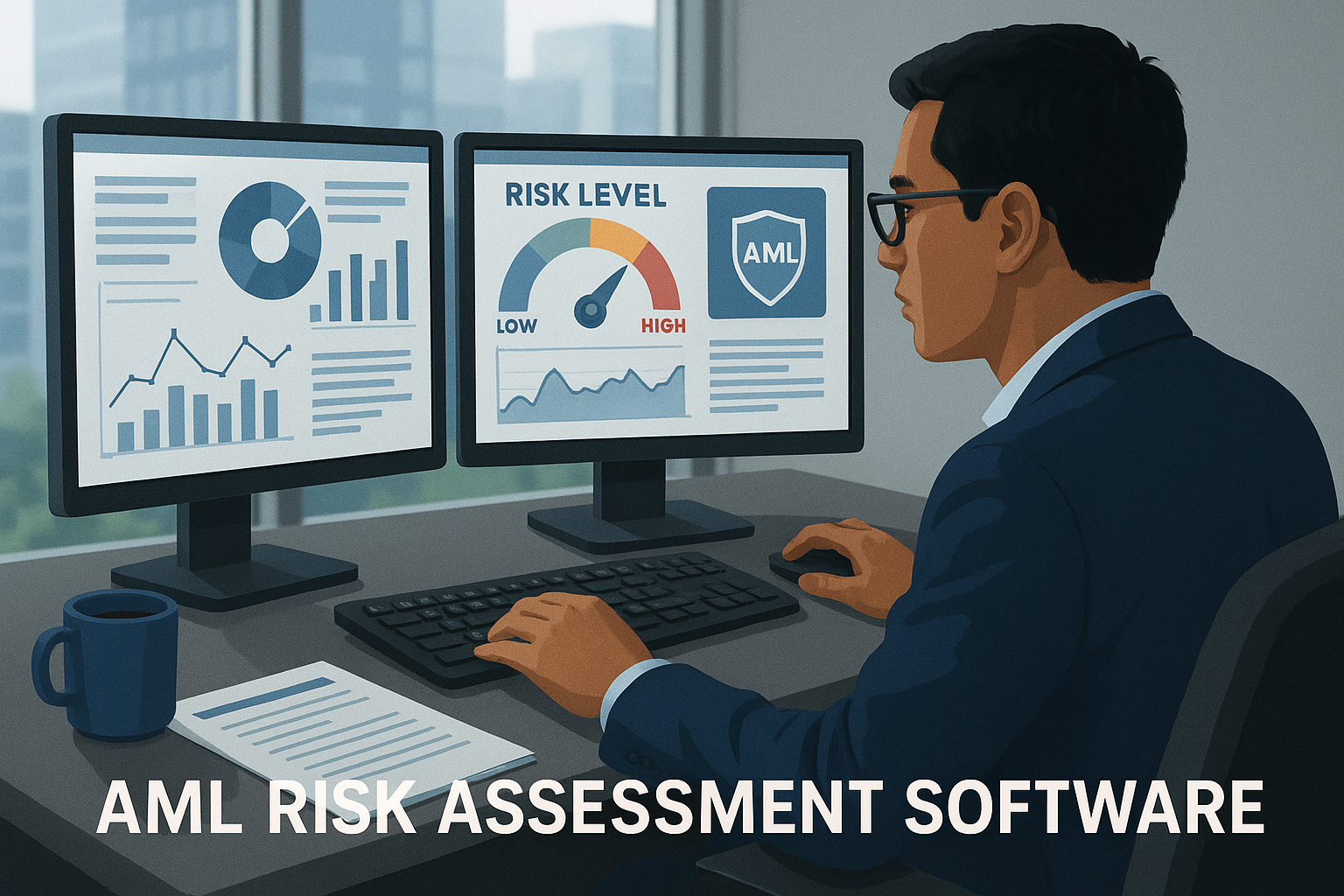Beyond the Basics: AML Software Features Every Financial Institution Needs
.svg)
AML software features are at the heart of modern financial crime prevention strategies.
In today’s complex regulatory landscape, financial institutions rely on advanced Anti-Money Laundering (AML) software to detect, investigate, and prevent illicit financial activity. The effectiveness of these tools hinges on their core features, each designed to address a critical stage in the compliance lifecycle.
From real-time transaction monitoring and customer due diligence (CDD) to sanctions screening and case management, these features work together to streamline operations, reduce false positives, and improve regulatory outcomes.
In this article, we break down the essential features of AML software, highlight how they support compliance teams, and explore why feature-rich solutions are becoming indispensable in the fight against financial crime.
The Importance of AML System Software in Financial Crime Prevention
AML system software is indispensable in the fight against financial crime. It plays a pivotal role in safeguarding economies from money laundering and terrorist financing activities.
By implementing robust software solutions, institutions enhance their ability to detect and block illicit financial flows. These systems provide real-time monitoring capabilities that are crucial for timely interventions.
The complexity of modern financial transactions requires advanced technology. AML software integrates with existing systems to provide a holistic view of financial activities.
Advanced algorithms and machine learning capabilities help identify suspicious patterns. This level of sophistication is necessary to stay ahead of increasingly complex criminal tactics.
Furthermore, these systems support compliance efforts by ensuring adherence to regulatory requirements. They provide the necessary tools for effective risk management and reporting, reducing the risk of penalties and reputational damage.

Understanding Regulatory Requirements and Compliance Efforts
Navigating regulatory requirements is a challenge for financial institutions. AML software serves as a compliance solution, ensuring adherence to global standards like those set by the Financial Action Task Force (FATF).
These systems are designed to address regulatory requirements efficiently. They automate record-keeping and reporting processes, reducing the burden on compliance teams.
AML software also supports efforts by providing detailed audit trails. This makes regulatory examinations and internal audits more manageable and transparent.
By enhancing compliance efforts, these systems help institutions avoid costly fines and sanctions. They also protect against reputational damage, a critical aspect of risk management.
The Role of AML Software in Risk Management
Risk management is central to the operations of any financial institution. AML software is instrumental in assessing and mitigating risks associated with money laundering.
These systems categorize clients based on their risk profiles, allowing for targeted monitoring. They adapt to changing conditions, ensuring that monitoring strategies remain effective.
By using machine learning, AML software predicts potential risks. It updates risk assessments and refines monitoring processes accordingly.
Additionally, these systems facilitate due diligence processes, ensuring a thorough understanding of client profiles. This proactive risk management approach is crucial in maintaining financial integrity.
Key Features of AML System Software
AML system software is equipped with numerous features that aid financial institutions in their anti-money laundering efforts. These features ensure an effective and comprehensive approach to combat financial crime.
One of the key components is transaction monitoring. This involves scrutinizing transactions for suspicious activity, thereby detecting potential money laundering attempts.
Customer due diligence is another vital feature. It helps institutions verify the identity of their clients and assess associated risk levels.
Sanctions list screening protects financial entities from dealing with high-risk individuals or entities. It compares client information with known sanctions lists to prevent illegal transactions.
Adverse media screening is also essential. It involves monitoring news sources for negative information about clients, which can signal potential risk.
Other significant features include:
- Integration with existing systems for seamless operation.
- Machine learning capabilities to enhance detection accuracy.
- Comprehensive reporting tools for compliance tracking.
- Real-time monitoring for prompt response to threats.
By leveraging these capabilities, institutions can effectively manage AML compliance and safeguard against financial crime.
{{cta-first}}
Transaction Monitoring and Suspicious Activity Detection
Transaction monitoring is crucial in identifying suspicious activities within financial systems. This feature employs sophisticated algorithms to flag transactions that deviate from normal patterns.
AML system software constantly analyzes large volumes of transactional data. It looks for signs of layering or structuring typical in money laundering schemes.
Once unusual activity is detected, the system alerts compliance officers. They can then investigate further to determine whether these actions are indeed illicit.
By using real-time monitoring, financial institutions can act swiftly to prevent financial crime. This proactive approach ensures that threats are identified and mitigated promptly.
Customer Due Diligence and Risk Profiling
Customer due diligence (CDD) is fundamental for assessing and minimizing risk. It involves verifying a client's identity and understanding their financial behavior.
AML software facilitates CDD by automating the collection and analysis of customer information. This efficiency is vital in maintaining accurate and up-to-date records.
The risk profiling component categorizes clients based on their risk levels. High-risk clients receive more frequent monitoring, ensuring adequate oversight.
Dynamic risk profiling adapts to changes in customer behavior. As new information becomes available, the system updates profiles to reflect current risk levels.
Sanctions List and Adverse Media Screening
Sanctions list screening is critical to ensure regulatory compliance. This process prevents financial entities from transacting with individuals or groups on government watchlists.
AML software compares customer data against various sanctions lists. Discrepancies trigger alerts, allowing institutions to halt potential illegal transactions.
Adverse media screening complements this by monitoring news and public records. Negative news about a client can indicate increased risk levels.
Automating this process aids in early detection of potential threats. It provides institutions with a comprehensive risk assessment of their clients' reputations.
Machine Learning and Reducing False Positives
Machine learning enhances the precision of AML systems. It learns from patterns in data, improving its ability to distinguish between genuine threats and false positives.
Traditional systems can generate numerous alerts, many of which are false positives. This inundates investigators, wasting valuable resources.
Machine learning algorithms refine this process, reducing false positives significantly. They learn from feedback and continuously refine their criteria for detecting anomalies.
Improving detection accuracy allows institutions to focus on true threats. It streamlines compliance efforts and ensures better allocation of investigative resources.
Integrating AML Software with Existing Systems
Integrating AML software with existing systems is crucial for seamless operations. It ensures that data flows smoothly across platforms, enhancing overall efficiency.
This integration minimizes the need for manual intervention, reducing the risk of error. It also allows for a consistent view of customer activities, which is vital for effective monitoring.
Modern AML solutions are designed with interoperability in mind. They can connect with various legacy systems, preserving valuable historical data.
Furthermore, integration supports a unified approach to risk management. By harmonizing data across systems, institutions can better manage compliance and detect financial crime.
Real-Time Processing and AML Transaction Monitoring
Real-time processing is a game-changer for AML transaction monitoring. It allows financial institutions to detect and respond to suspicious activities instantly.
This capability enhances the speed of compliance decisions. Swift action is often necessary to prevent money laundering from succeeding.
With real-time monitoring, alerts are generated and delivered as soon as anomalies are identified. This immediacy aids in prompt investigations.
Moreover, real-time data processing supports adaptive risk management. It allows institutions to adjust their strategies based on live information, ensuring robustness against dynamic threats.
Scalability and Adaptability to Regulatory Changes
AML software must be scalable to accommodate growing transaction volumes. As financial institutions expand, their systems need the capacity to handle more data without sacrificing performance.
Scalability also extends to adapting to increasingly complex financial transactions. AML software should evolve alongside business needs to remain effective.
Adapting to regulatory changes is equally critical. AML regulations are dynamic, and software solutions must be flexible to keep up.
By ensuring both scalability and adaptability, financial institutions can maintain compliance. This prepares them for future challenges and guards against emerging financial crime risks.
{{cta-whitepaper}}
Leveraging AML Software to Advance Compliance
AML software is transforming the way financial institutions detect and prevent money laundering. By integrating advanced technologies, these tools help streamline compliance workflows and improve risk detection accuracy.
Modern anti-money laundering software employs advanced analytics and machine learning to sift through massive datasets, uncovering even the most subtle suspicious activity. This leads to faster, more precise identification of financial crime.
Automation in AML compliance software significantly reduces manual effort. By automating routine checks, alerts, and reporting, institutions can allocate more time and resources to high-risk investigations and strategic compliance initiatives.
Moreover, AML software supports real-time transaction monitoring, enabling institutions to stay compliant in a fast-evolving regulatory environment and maintain operational resilience.=
The Future of AML Software: AI, Blockchain, and Cloud Capabilities
The future of AML software is powered by emerging technologies. AI-driven AML solutions continue to improve by learning from historical data and identifying sophisticated laundering tactics with higher precision.
Blockchain-based AML tools offer transparent, tamper-proof audit trails, making them valuable for transaction verification and regulatory reporting.
Cloud-native AML compliance software brings scalability and agility to compliance operations. It allows institutions to manage growing data volumes and rapidly respond to regulatory changes without overhauling infrastructure.
Together, these innovations are shaping the next generation of AML software—solutions that are faster, smarter, and more adaptable to complex financial crime threats.
Why Human Expertise Still Matters in AML Software Implementation
Even the most advanced AML software relies on human expertise for effective implementation and oversight.
Skilled compliance professionals are essential to interpret complex data, validate alerts, and make informed decisions. Regular training ensures teams stay updated on the latest AML technologies and financial crime trends.
Additionally, human oversight enhances trust and accountability in automated AML systems, especially in high-stakes cases involving nuanced judgments.
The most effective AML strategies blend cutting-edge software with experienced human insight—creating a holistic compliance approach that strengthens both detection and prevention.
Conclusion: Embracing AML Software for Smarter Financial Crime Detection
To conclude, adopting Tookitaki’s FinCense AML software represents a next-generation approach to tackling financial crime. Purpose-built for banks and fintechs, FinCense provides an efficient, accurate, and scalable platform that elevates your AML compliance operations.
With real-time updates from the AFC Ecosystem, FinCense ensures 100% risk coverage across all AML scenarios—keeping your institution protected against evolving threats through continuously updated intelligence and expert-driven insights.
FinCense’s advanced machine learning capabilities also drive up to 50% cost reduction in compliance operations by minimising false positives and focusing resources on high-priority risks. This leads to faster investigations and improved SLA performance in compliance reporting.
Backed by AI-powered models with over 90% real-time detection accuracy, Tookitaki’s AML software helps your team stay one step ahead of suspicious activities—supporting regulatory alignment while boosting operational efficiency and trust.
Tookitaki’s FinCense AML software is not just a tool—it’s a strategic investment in future-ready compliance. Embrace intelligent, collaborative, and adaptive AML systems with Tookitaki and stay resilient in the fight against financial crime.
Experience the most intelligent AML and fraud prevention platform
Experience the most intelligent AML and fraud prevention platform
Experience the most intelligent AML and fraud prevention platform
Top AML Scenarios in ASEAN

The Role of AML Software in Compliance

The Role of AML Software in Compliance










